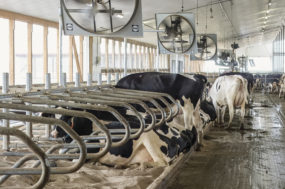Are you thinking about building a new barn or milking center? It may seem like a simple business decision, but those of you who have built a new building or completed a major remodeling project know the process involves making thousands of decisions. Unfortunately, some farm owners assume that people constructing the building or installing the equipment, plumbing, wiring and other parts of the project know what to do and what is wanted. Sometimes the people hired do an excellent job and the owner is extremely happy with their work. However, sometimes the people hired don’t do the job that is wanted and the owner is an unhappy customer with a building that does not work well.
So if you, as dairy manager or farm owner, are going to build a new building or remodel one, will you make the thousands of decisions needed or will you delegate those decisions to others? If you delegate decision-making to someone else, do they know what you want and have the experience to make good decisions? If you aren’t clear on your expectations, don’t be surprised if you don’t get what you want.
New buildings and major remodeling projects don’t happen very often, so many people do not have experience managing construction projects. Dairy managers working full-time managing a complex dairy operation may not have the time to oversee the project.
One option is to hire an experienced construction manager. Siting and construction mistakes can be expensive to repair or, if unrepairable, be a major drag on the operation’s efficiency and productivity.
Several years ago a dairy producer talked about a remodeling project where he and his employees sat down and looked at drawings that showed how the gates were going to be hung. They discovered some gates were going to make cow and equipment movement difficult.
The time they spent looking over those drawings saved them hours of frustration with gates hung the wrong way or the effort that would be needed to re-hang the gates.
Another producer talked about taking over a year to plan a new dairy. He gathered recommendations and visited numerous dairies looking for ideas to incorporate into his dairy.
Building layout has a tremendous impact on cow movement, manure handling, feeding, veterinary care, hoof trimming, heat detection and many other tasks.Building design impacts ventilation and cow comfort. A well-planned dairy is efficient.
Blueprints are an important way to describe to builders and subcontractors what will be built and installed and where. Blueprints can be hard to read at first but, with some effort, most people can understand blueprints well enough to make sure that what is built will meet their needs.
Blueprints summarize building strength (for example, snow and wind loads to withstand); where freestalls, waterers, waterlines, ventilation inlets and outlets will be placed; what lighting will be installed and where it will be installed; where switches and electrical outlets will be located and how gates will be hung.
Blueprints also give concrete specifications. While it costs money to have building specifications written down and blueprints drawn up, they improve your chances of having your building built the way you want it. It is less expensive to change a blueprint than to change the building after it has been built.
Building codes establish minimum requirements to safeguard public health, safety and general welfare. These codes specify requirements for strength, stability, sanitation, lighting and ventilation; energy conservation and safety for occupants from fire and other hazards and to provide safety for firefighters and emergency responders during emergency operations.
Electrical and plumbing codes establish minimum requirements as well. One important decision that needs to be made is will your building be built to meet these codes even if it is not required, as in some states.
You should expect your building to exceed the requirements of your insurance company to make sure it is insurable. The RAM Mutual Insurance Company published a Fire Safety and Construction Handbook for Agricultural Buildings in 2010. The handbook has information about roof and wind loads, fire stops and walls, building materials, electrical wiring, LP gas and fuel tank locations and other safety and health issues.
A copy can be purchased by calling them at (218) 879-3321 and asking for the green fire safety and construction handbook for agricultural buildings. The 56-page book costs $5. Work with your insurance company, building contractors and subcontractors to make sure your new building is insurable.
Establishing clear expectations and communicating effectively with experienced builders and subcontractors will enhance your chances for a successful building that will be efficient and productive for your dairy operation. PD
—Excerpts from University of Minnesota Extension website:
http://www1.extension.umn.edu/dairy/facilities/building-decisions/index.html





